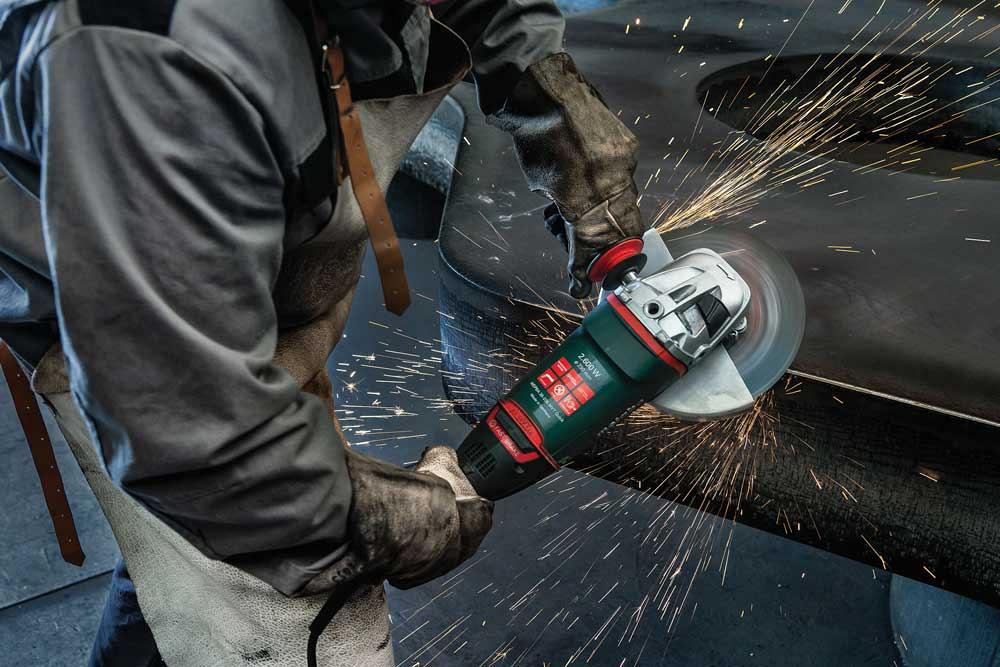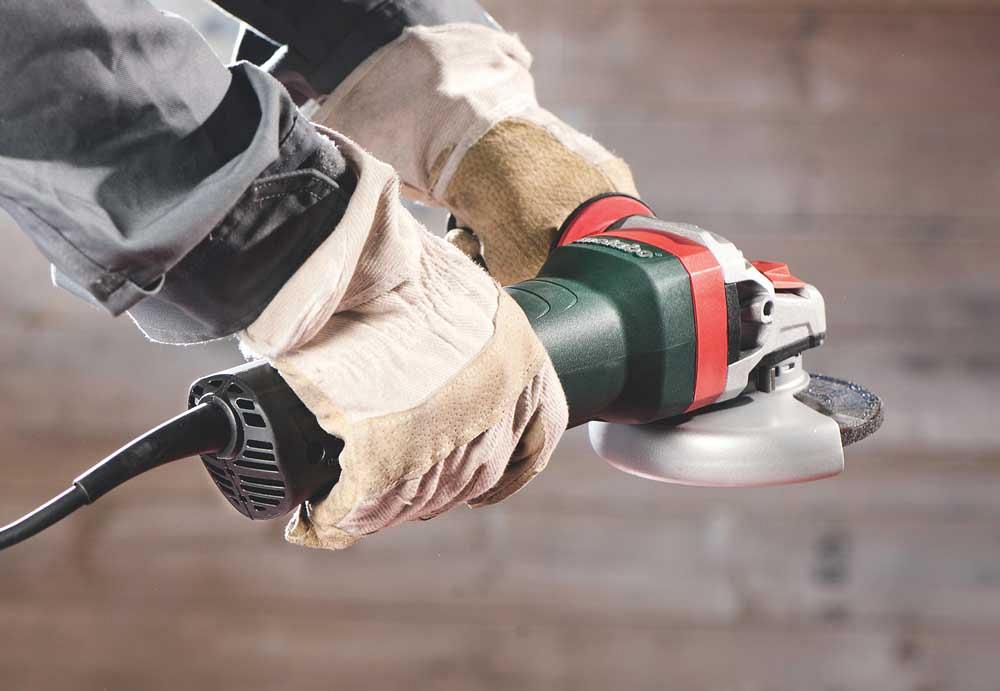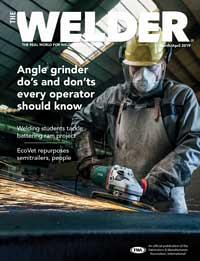- FMA
- The Fabricator
- FABTECH
- Canadian Metalworking
Categories
- Additive Manufacturing
- Aluminum Welding
- Arc Welding
- Assembly and Joining
- Automation and Robotics
- Bending and Forming
- Consumables
- Cutting and Weld Prep
- Electric Vehicles
- En Español
- Finishing
- Hydroforming
- Laser Cutting
- Laser Welding
- Machining
- Manufacturing Software
- Materials Handling
- Metals/Materials
- Oxyfuel Cutting
- Plasma Cutting
- Power Tools
- Punching and Other Holemaking
- Roll Forming
- Safety
- Sawing
- Shearing
- Shop Management
- Testing and Measuring
- Tube and Pipe Fabrication
- Tube and Pipe Production
- Waterjet Cutting
Industry Directory
Webcasts
Podcasts
FAB 40
Advertise
Subscribe
Account Login
Search
Angle grinder safety
Best practices, PPE, and vigilance are the keys to injury prevention
- By Amanda Carlson
- Updated October 25, 2023
- March 12, 2019
- Article
- Finishing

Operators should wear safety glasses, FR clothing, and gloves while using an angle grinder. Depending on the application, an operator might also require a face shield and a respirator.
Terry Tuerk, senior product manager—North America at Metabo, West Chester, Pa., uses two analogies to describe just how dangerous it can be to operate an angle grinder. The first compares using an angle grinder to a machine with a knife (the wheel) attached that is moving 220 MPH just inches away from your finger. The second is a person attempting to get out of the way of a Formula 1 car that is only 5 feet away and traveling 220 MPH.
In both scenarios it is humanly impossible to remove yourself from danger (i.e., impact) should something go awry.
Angle grinders are power tools found in just about every metalworking environment. And just like other metalworking equipment, they are dangerous if they are not treated with the care and respect that they command.
Tuerk candidly discusses some of the most common mistakes angle grinder operators make and why those mistakes could be detrimental to their personal safety.
Angle Grinder Safety Tips
TW: What makes angle grinders so dangerous?
An angle grinder is a tool that needs to be respected. Whether the accessory on that angle grinder is a grinding disc, a cutting disc, or a wire wheel, you have something that is spinning at speeds anywhere from 9,000 to 11,000 RPM, inches from your hands, fingers, body, and face.
We’ve studied the statistics put out by the Bureau of Labor Statistics (BLS) on injuries, and it’s interesting to see that it’s generally two groups of people who are being injured while using angle grinders. It’s either very young people who are just entering the industry or it’s people who have been in the industry 15 or 20 years.
Injuries in the first group are usually the result of a lack of training, where either they don’t know the process, they don’t respect the equipment, or they don’t understand the safety features that are on the grinders. The second group are the people who insist they have been doing it a certain way for years. I can guarantee you, if you are running an angle grinder for your job without a guard, at some point you are going to be injured by that grinder. That is a fact, 100 percent.
TW: Can you describe an unsafe grinding operation you’ve had to deal with?
Several years ago we manufactured a 5-in. variable-speed grinder, with a range somewhere between 2,000 and 10,000 RPM. Since it’s a 5-in. angle grinder, it leaves our factory with a 5-in. guard.
All of a sudden we saw a rash of these tools coming back to us for service—all from one location—each with a 9-in. guard welded around our 5-in. grinder, and the variable speed locked in at around 6,000 RPM. And we were like, “Eh, this is not safe.” So we removed the 9-in. guard and replaced it with the standard 5-in. guard. We also fixed the variable-speed dial so that it worked again up to its full range, and then sent them back to the customer. We started getting phone calls from the customer saying, “No, we’ve done that on purpose, we need our guards back.” We told them that as the manufacturer we could not do that.
We looked further into this and found that they were trying to grind a root weld on a 36-in.-dia. pipe that had a 6-in.-thick wall. They had to get to the root weld on this pipe and the 5-in. angle grinder could not get down to the root unless it had a 9-in. wheel on it. This practice ran up through the ranks of the customer and was approved by their international safety people because it was the only way they could get their jobs done. We wouldn’t send them back with their guards, but what it led to on our part was the development of the flat-head angle grinder.
TW: Why is it so dangerous to use a wheel that is too big for the grinder?
You greatly increase the possibility of kickback, which is when a wheel binds up or gets caught in the workpiece during operation. The inertia created by the spinning wheel and the mass of the armature inside the motor cause the tool to stop suddenly, creating a situation where the tool wants to kick out of your hands. When this happens, it typically kicks back toward the operator.
TW: Can you explain the primary function of the guard?
Guards are designed to contain a wheel or disc in the event that it shatters or breaks. Specific design standards for the guard require the guard material to be a certain thickness and steel strength to contain a broken wheel. It also must have a locking mechanism so that if it were to shatter, that guard could not open itself automatically to the operator. Most angle grinders have a burstproof guard.
In the past you’d have a guard that just clamped onto the grinder with a steel ring and a screw. That’s no longer acceptable. You now have to have a locking guard, so we have developed a guard that has seven different locking positions. You can lock it in a cutting position on the right- or left-hand side of the tool, and in many positions in between for grinding as well. But it’s locked in that position. If you had an event where the disc shattered, it could not open up toward you.
Preventing Angle Grinder Injuries
TW: What are some ways operators customize their tool that might seem harmless but are actually very unsafe?
The No. 1 thing that we see is taking the guard off the tool. The excuse is that the guard is in the way and people can’t see what they’re doing. In the past that may have been true, but today any major manufacturer offers positionable guards. You can change the position of the guard for cutting or grinding to allow you to get into areas that are tight.
Right behind that is not using the side handle on the angle grinder. Many users say the side handle gets in the way, so the first thing they do when they open the box is leave the side handle in there, which is a mistake.

Never remove a guard from the angle grinder. Tuerk said guards are designed to contain a wheel or disc in the event that it shatters or breaks.
You should always have two hands on the tool. If you have one hand on the handle located on the back of the grinder and one hand on the side handle, it gives you so much more control than if you were to have two hands on the back of the grinder, like how you would grip a baseball bat.
We’ve tried to minimize the underuse of the side handle by developing a multiposition side handle. Our small grinders still come with a side handle that can mount either to the left or the right side of the grinder. Our large grinders typically have a three-position side handle where you can mount it from the left, right, or on top of the gear housing.
With the multiposition accessory, it’s a steel bar that connects to the grinder that allows you to position the side handle anywhere across the top of the grinder on a 180-degree arc from left to right. And it also allows you to position the side handle at 90 degrees to the tool and back toward you at 45 degrees. We’ve given the operators a reason to keep that side handle on the tool to increase safety. It takes away the excuse that it’s in the way.
On many large job sites anymore, not using a guard or a side handle is reason enough for termination. You’ll be taken off the job. If it’s a union job, you’ll be asked to leave. If you’re a hired employee, you’ll be fired. It’s that serious in a lot of cases.
I’ve even seen people using accessories that are not designed for an angle grinder, for example, a toothed saw blade. Every instruction manual in the industry warns operators not to use a toothed saw blade on an angle grinder, and the reason for that is obvious. Think about it: An abrasive cutting disc can injure you fairly significantly, but a saw blade designed to operate at 3,500 RPM now attached to an angle grinder running at 10,000 RPM? The damage would be a whole lot worse. We’ve seen it; it’s out there. The chances for kickback on this is multiplied 10 times over.
When there’s a job that needs to be done, sometimes people act before they think it through.
TW: What PPE must an operator wear at all times, no exceptions?
You absolutely need to wear safety glasses that not only cover the front of the eye, but also shield the side of the eye. You need hearing protection. The angle grinder itself might not be loud, but the sound the disc makes on the material greatly amplifies the sounds that are made. You should wear spark-resistant gloves at all times, and I would also suggest wearing a fire-retardant (FR) jacket or clothing. Those safety items are the baseline.
Depending on your application, you may need to wear a full-face shield in addition to safety glasses. If you are working with your face very close to the grinder, the sparks could bounce off the workpiece and come at you.
If you’re working inside or in a confined environment like inside of a tank, then you should wear a dust respirator of some sort. You need to be aware of the material that you’re working on. If you’re grinding stainless steel or if you’re grinding on something that could include a leaded component—a wire brush removing leaded paint—then you need to wear a respirator that will protect you from those hazardous dusts.

The side handle allows the operator to use two hands during cutting or grinding applications. Placing one hand on the handle located on the back of the grinder and the other hand on the side handle gives the operator more control of the tool. More control equates to more safety.
TW: Are there any characteristics operators should look for in their grinding or cutting wheel before they begin work?
When you remove a disc from the packaging, the first thing you should do is inspect it for any defects. Look for chips, cracks, or anything that looks off. If something looks questionable, dispose of it. Do not mount it on your tool.
After you’ve inspected and mounted the wheel, run it at no load for at least a minute before you do anything else with that tool. In that time you’ll be able to determine if that disc has full integrity. If you’re working in a shop environment, make sure you are pointing it away from anyone else. You should run the disc at no load for about a minute any time you change accessories to make sure it doesn’t come apart. I don’t think many people do this but it’s definitely a recommendation found in angle grinder instruction manuals. It’s also found in ANSI B7.1, the regulations for abrasives. It’s an end-user standard developed by Unified Abrasives Manufacturers Association (UAMA).
TW: What are some general best practices users should adopt to provide an extra level of safety?
If your angle grinder goes in and out of a tool crib every day, and if that tool crib issues you a grinder with an accessory on it, make sure to let it run no load for a minute. This will allow you an opportunity to inspect the tool and the accessory. Do the same thing if you go on break—you don’t know if someone else has picked up that grinder and dropped it.
If you ever drop your angle grinder with an accessory attached, the safest thing to do is assume you’ve damaged it in some way and change out that accessory. The cost of changing out that cutting or grinding disc pales in comparison to what a potential injury will cost.
Last, the operator is the biggest component in ensuring a safe operation. Never operate the tool under the influence of alcohol or drugs. If you see something unsafe, bring it up to your supervisor or safety person. Don’t ignore it. We need to take care of each other.
If you’re not feeling 100 percent, you probably don’t want to have a power tool in your hand that day. When you get tired—operating these tools is hard work so it happens—take a break and get away from it for a while. If you find your mind wandering a little bit, get it out of your mind and concentrate on your job.
Remember, an accident with an angle grinder happens before you have time to react.
About the Author

Amanda Carlson
2135 Point Blvd
Elgin, IL 60123
815-227-8260
Amanda Carlson was named as the editor for The WELDER in January 2017. She is responsible for coordinating and writing or editing all of the magazine’s editorial content. Before joining The WELDER, Amanda was a news editor for two years, coordinating and editing all product and industry news items for several publications and thefabricator.com.
About the Publication
subscribe now

The Welder, formerly known as Practical Welding Today, is a showcase of the real people who make the products we use and work with every day. This magazine has served the welding community in North America well for more than 20 years.
start your free subscription- Stay connected from anywhere

Easily access valuable industry resources now with full access to the digital edition of The Fabricator.

Easily access valuable industry resources now with full access to the digital edition of The Welder.

Easily access valuable industry resources now with full access to the digital edition of The Tube and Pipe Journal.
- Podcasting
- Podcast:
- The Fabricator Podcast
- Published:
- 04/16/2024
- Running Time:
- 63:29
In this episode of The Fabricator Podcast, Caleb Chamberlain, co-founder and CEO of OSH Cut, discusses his company’s...
- Trending Articles
Sheffield Forgemasters makes global leap in welding technology

Welding student from Utah to represent the U.S. at WorldSkills 2024

Lincoln Electric announces executive appointments

Engine-driven welding machines include integrated air compressors

ESAB unveils Texas facility renovation

- Industry Events
16th Annual Safety Conference
- April 30 - May 1, 2024
- Elgin,
Pipe and Tube Conference
- May 21 - 22, 2024
- Omaha, NE
World-Class Roll Forming Workshop
- June 5 - 6, 2024
- Louisville, KY
Advanced Laser Application Workshop
- June 25 - 27, 2024
- Novi, MI



























